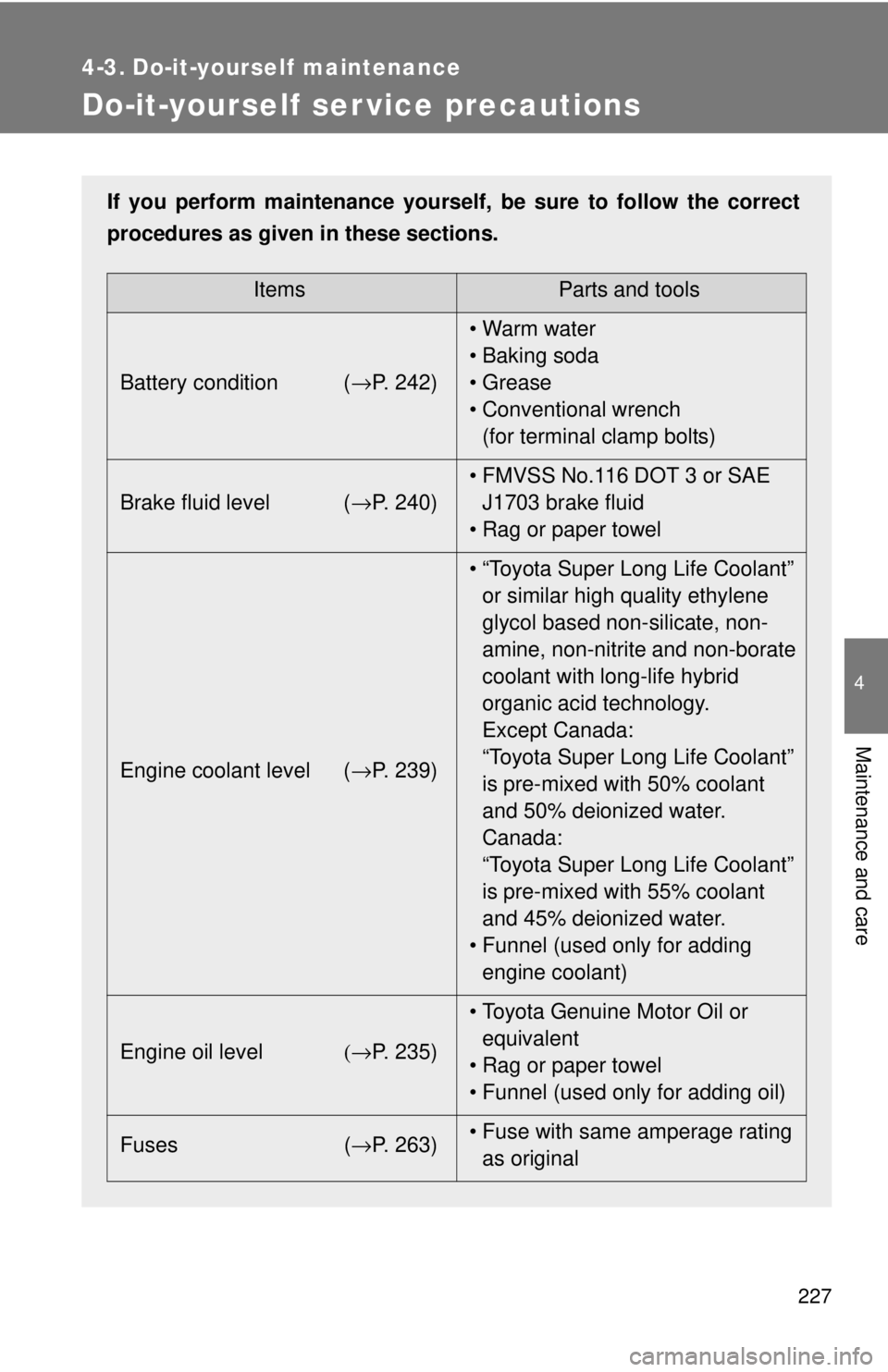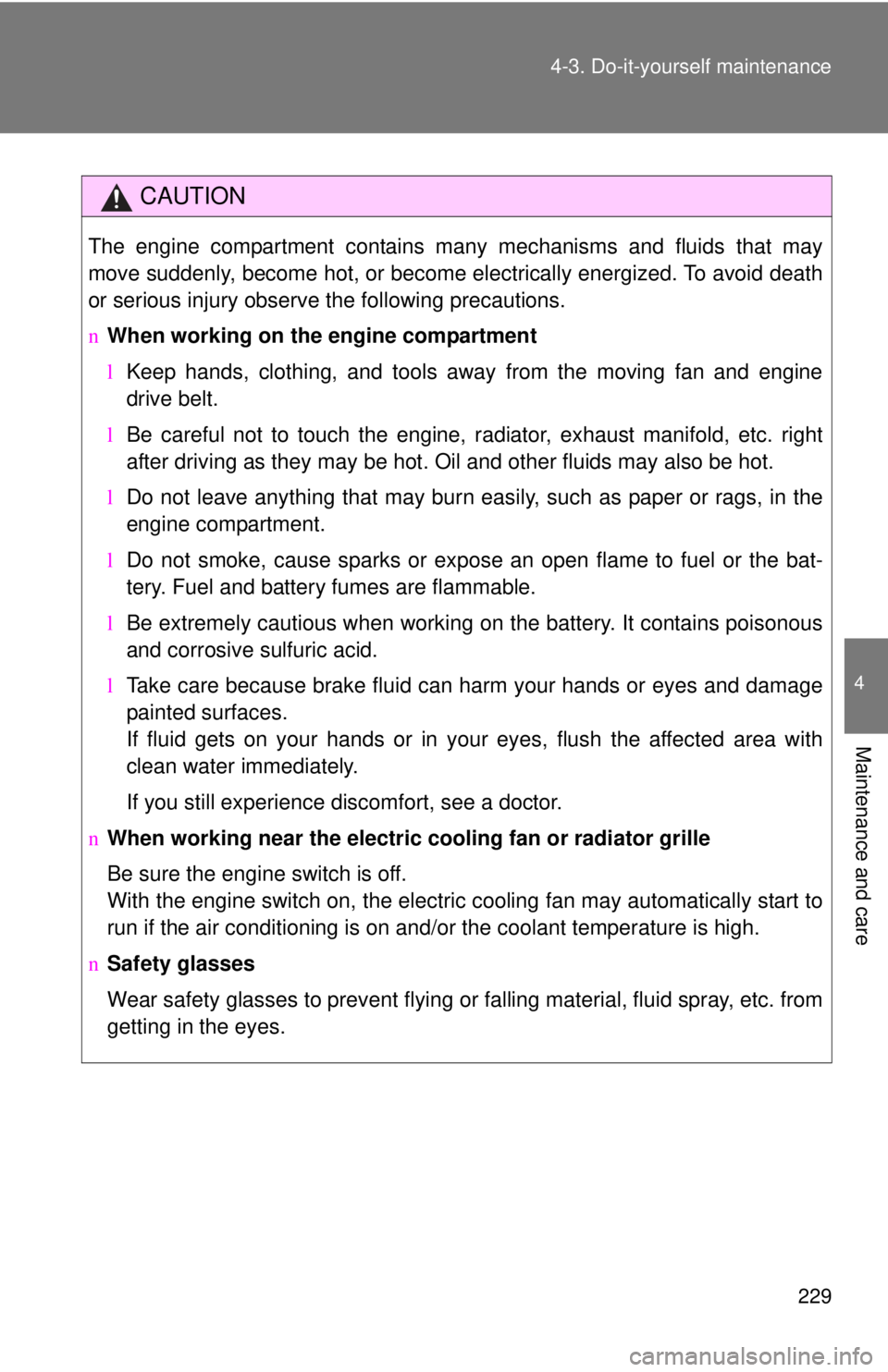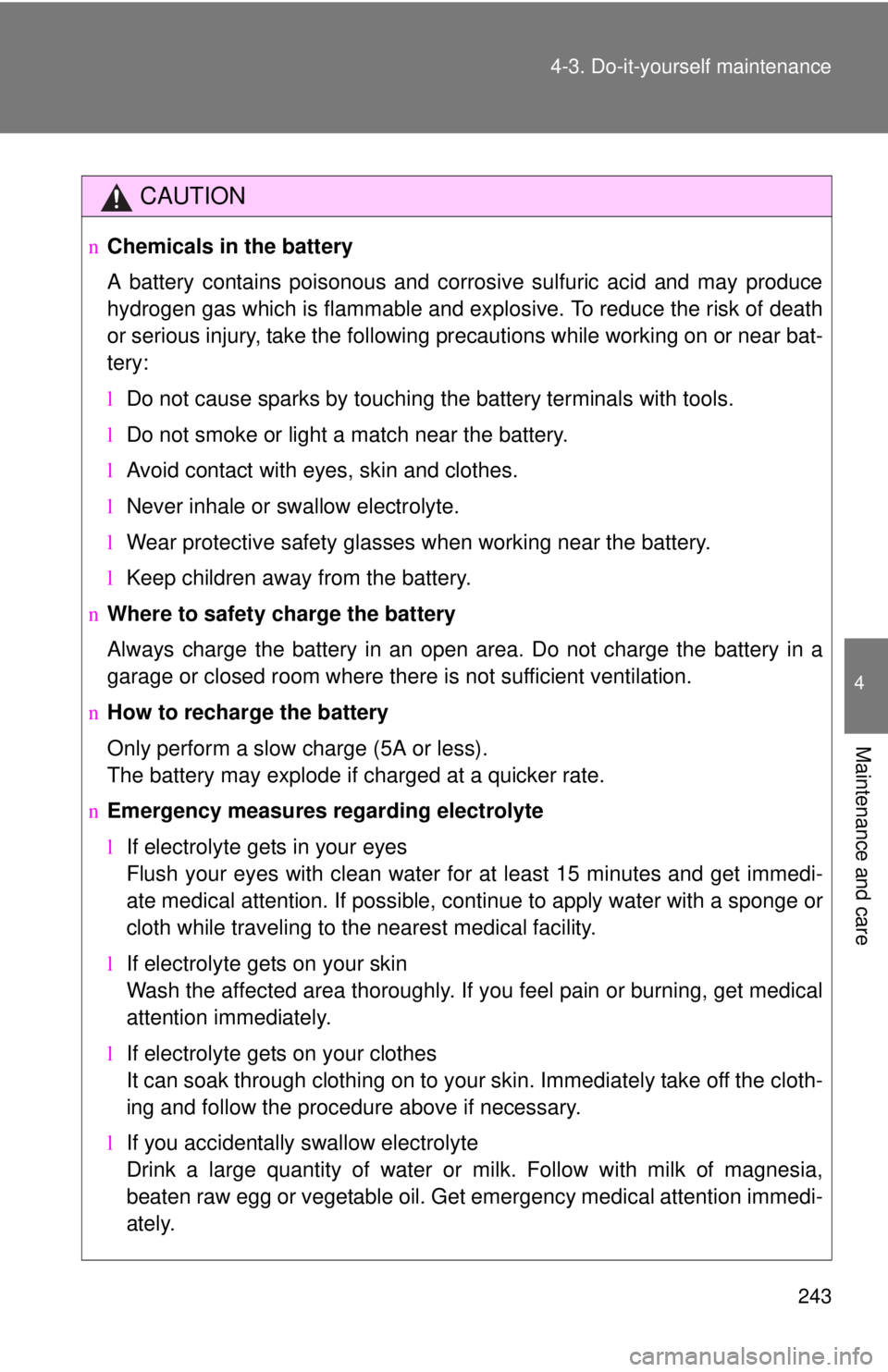Page 238 of 386

227
4
Maintenance and care
4-3. Do-it-yourself maintenance
Do-it-yourself ser vice precautions
If you perform maintenance yourself, be sure to follow the correct
procedures as given in these sections.
ItemsParts and tools
Battery condition ( →P. 242)•Warm water
• Baking soda
• Grease
• Conventional wrench
(for terminal clamp bolts)
Brake fluid level ( →P. 240)• FMVSS No.116 DOT 3 or SAE
J1703 brake fluid
• Rag or paper towel
Engine coolant level ( →P. 239)• “Toyota Super Long Life Coolant”
or similar high quality ethylene
glycol based non-silicate, non-
amine, non-nitrite and non-borate
coolant with long-life hybrid
organic acid technology.
Except Canada:
“Toyota Super Long Life Coolant”
is pre-mixed with 50% coolant
and 50% deionized water.
Canada:
“Toyota Super Long Life Coolant”
is pre-mixed with 55% coolant
and 45% deionized water.
• Funnel (used only for adding engine coolant)
Engine oil level (→P. 235) • Toyota Genuine Motor Oil or
equivalent
• Rag or paper towel
• Funnel (used only for adding oil)
Fuses ( →P. 263)• Fuse with same amperage rating
as original
Page 240 of 386

229
4-3. Do-it-yourself maintenance
4
Maintenance and care
CAUTION
The engine compartment contains many mechanisms and fluids that may
move suddenly, become hot, or become electrically energized. To avoid death
or serious injury observe the following precautions.
n
When working on the engine compartment
lKeep hands, clothing, and tools away from the moving fan and engine
drive belt.
l Be careful not to touch the engine, radiator, exhaust manifold, etc. right
after driving as they may be hot. Oil and other fluids may also be hot.
l Do not leave anything that may burn easily, such as paper or rags, in the
engine compartment.
l Do not smoke, cause sparks or expose an open flame to fuel or the bat-
tery. Fuel and battery fumes are flammable.
l Be extremely cautious when working on the battery. It contains poisonous
and corrosive sulfuric acid.
l Take care because brake fluid can harm your hands or eyes and damage
painted surfaces.
If fluid gets on your hands or in your eyes, flush the affected area with
clean water immediately.
If you still experience discomfort, see a doctor.
n When working near the electric cooling fan or radiator grille
Be sure the engine switch is off.
With the engine switch on, the electric cooling fan may automatically start to
run if the air conditioning is on and/or the coolant temperature is high.
n Safety glasses
Wear safety glasses to prevent flying or falling material, fluid spray, etc. from
getting in the eyes.
Page 245 of 386
234
4-3. Do-it-yourself maintenance
Engine compar tment
Washer fluid tank (→P. 244)
Engine oil filler cap (→ P. 235)
Engine oil level dipstick (→ P. 235)
Radiator cap
Battery ( →P. 242)
Brake fluid reservoir (→ P. 240)Fuse box ( →P. 263)
Condenser ( →P. 240)
Electric cooling fan
Engine coolant reservoir (→ P. 239)
Radiator ( →P. 240)
Page 253 of 386
242 4-3. Do-it-yourself maintenance
Batteryn Battery exterior
Make sure that the battery terminals are not corroded and that
there are no loose connections, cracks, or loose clamps.
Te r m i n a l s
Hold-down clamp
nBefore recharging
When recharging, the battery produces hydrogen gas which is flammable
and explosive. Therefore, before recharging:
lIf recharging with the battery installed on the vehicle, be sure to discon-
nect the ground cable.
l Make sure the power switch on the charger is off when connecting and
disconnecting the charger cables to the battery.
Page 254 of 386

243
4-3. Do-it-yourself maintenance
4
Maintenance and care
CAUTION
n
Chemicals in the battery
A battery contains poisonous and corrosive sulfuric acid and may produce
hydrogen gas which is flammable and explosive. To reduce the risk of death
or serious injury, take the following precautions while working on or near bat-
tery:
l Do not cause sparks by touching the battery terminals with tools.
l Do not smoke or light a match near the battery.
l Avoid contact with eyes, skin and clothes.
l Never inhale or swallow electrolyte.
l Wear protective safety glasses when working near the battery.
l Keep children away from the battery.
n Where to safety charge the battery
Always charge the battery in an open area. Do not charge the battery in a
garage or closed room where there is not sufficient ventilation.
n How to recharge the battery
Only perform a slow charge (5A or less).
The battery may explode if charged at a quicker rate.
n Emergency measures regarding electrolyte
lIf electrolyte gets in your eyes
Flush your eyes with clean water for at least 15 minutes and get immedi-
ate medical attention. If possible, continue to apply water with a sponge or
cloth while traveling to the nearest medical facility.
l If electrolyte gets on your skin
Wash the affected area thoroughly. If you feel pain or burning, get medical
attention immediately.
l If electrolyte gets on your clothes
It can soak through clothing on to your skin. Immediately take off the cloth-
ing and follow the procedure above if necessary.
l If you accidentally swallow electrolyte
Drink a large quantity of water or milk. Follow with milk of magnesia,
beaten raw egg or vegetable oil. Get emergency medical attention immedi-
ately.
Page 255 of 386
244 4-3. Do-it-yourself maintenance
Washer fluidIf any washer does not work or the low washer fluid warning light
comes on (if equipped), the wa sher tank may be empty.
Open the lid.
Add washer fluid.
NOTICE
nWhen recharging the battery
Never recharge the battery while the engine is running. Also, be sure all
accessories are turned off.
Page 272 of 386
261
4-3. Do-it-yourself maintenance
4
Maintenance and care
Key batter y
Replace the battery with a new one if it is discharged.
nYou will need the following items:
lFlathead screwdriver (To prevent damage to the key, cover
the tip of the screwdriver with plastic tape.)
l Lithium battery CR2016
n Replacing the battery
Remove the cover.
Remove the module.
Remove the battery cover and
the depleted battery.
Insert a new battery with the
“+” terminal facing up.
Page 273 of 386
262 4-3. Do-it-yourself maintenance
nIf the key battery is discharged
The following symptoms may occur.
lThe wireless remote control will not function properly.
l The operational range is reduced.
n Use a CR2016 lithium battery
lBatteries can be purchased at your Toyota dealer, jewelers, or camera
stores.
l Replace only with the same or equivalent type recommended by your
Toyota dealer.
l Dispose of used batteries according to the local laws.
CAUTION
nRemoved battery and other parts
Keep away from children.
These parts are small and if swallowed by a child they can cause choking.
NOTICE
nFor normal operation after replacing the battery
Observe the following precautions to prevent accidents.
lAlways work with dry hands.
Moisture may cause the battery to rust.
l Do not touch or move any other components inside the remote control.
l Do not bend either of the battery terminals.